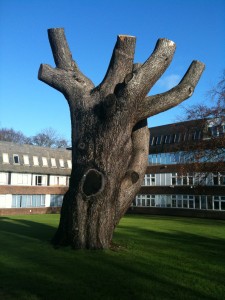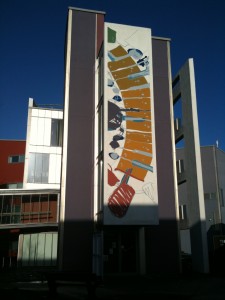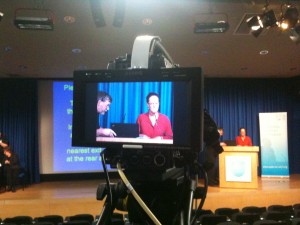This is the second of a two-part post. See the first post.
A very nice feature of the campus (using these photos is leading me to talk much more about the campus itself than I intended, but there you go) was its landscaping. Much of the landscaping being implemented during my time at the OU was quite sensible stuff: flowerbeds giving way to tall grass and native plants that require much less maintenance. I’ve always hypothesised – without ever investigating – that halfway through my time at the OU, a very nice chief landscape gardener reached the end of her/his career and retired, replaced by another very nice chief landscape gardener who made it his/her agenda to introduce new techniques and practices of landscaping to the campus. Improbable, I know, but I like to imagine that’s what happened.
Very near to my final days, I looked out my office’s window to see that carefully-sculpted sections of grass sod were being removed to expose the topsoil beneath. We later learned that a vegetable garden was being introduced, which was going to be used by the central catering facility at the campus (also then being refurbished), which I thought was great. We found out that this specifically was happening through one of the Faculty Administrators, who went out and asked the workmen, who were turning up all this grass sod, what was going on. I mention this as an aside because in telling her they also registered their opinion what they were doing was a bad thing since ‘so many people are out of work these days’; i.e. presumably that this will just take jobs away from the food industry in a recession. I don’t necessarily agree with that, but it does illustrate the oft-mentioned tension between green and red (labour) politics.

The Lebanon tree, violated
One thing that really defined my experience of the OU was actually reaching it. Like many central academic staff members, I did not live in Milton Keynes during my employment with the OU. One way to get there is driving, of course, a mode in which I myself partook from time to time.

OU Ring Road East

Stuart Hall Building

Wendy Brown through the lens
This leads me to end this unintentionally-long post with a point about the OU for which I won’t lead from any particular aspect of the campus. This is to say that I always thought there was a very ‘open’ culture at the OU (no pun intended).There was just this distinctive disposition at the place to get together and thrash through various matters of theory, method and politics, even if said matters were not in people’s area of focus. A few people suggested that this came from the way courses are developed and managed at the OU – not by one person but by teams of different people who usually try to get at the very kernel of things (and generally, to not take existing literature as the given way into the subject). I think this is more than accurate. Another factor, of course, noted especially by those with a long history at the OU, was the university’s mission of social progress, and commitment to being accessible to a broad community of students (and, potentially, researchers too). This teaching style and mission really appeals to some; those that don’t connect to this peculiar situation have apparently tended to depart quite rapidly. To be fair, there’s also the issue of not having much contact with students, which I personally found difficult (even though my prior teaching was only during my PhD). But for those who can handle that, and who wish to make the most out of this unique environment, the OU is without doubt a truly incomparable place to work.
[…] Continued in part two… […]
Designers draw in whatever style is necessary or interesting. Garden
Interesting comment, Garden, very deep indeed. Er, call me a cynic, but did you merely add this comment so as to have one more link to your blog?